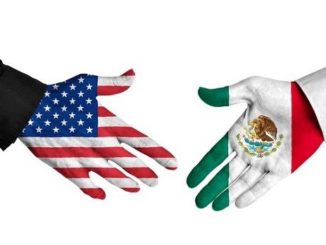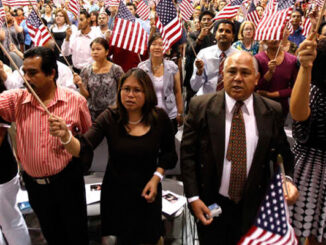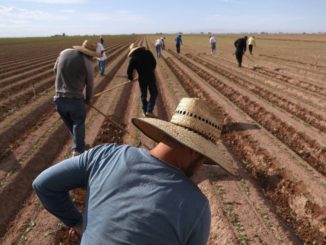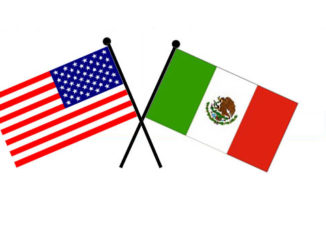
by
Is the border dangerous, or as Trump contends, “very dangerous”?
It is an important question at a moment when the government faces a shutdown over the fate of “dreamers,” undocumented immigrants who were brought to the United States as children, while the Trump administration seeks to link immigration and terrorism.
The answer depends on who you are and where you find yourself.
For U.S. citizens north of the border
If you are an American concerned about safety, your best statistical bet is to live close to the border. The crime rates in U.S. border counties are lower than the average for similarly sized inland counties, with two exceptions out of 23 total, according to an upcoming analysis by the Mexico Institute at the Wilson Center, a Washington think tank. “There is no doubt, the U.S. side [of the border] is a very safe place,” said Christopher Wilson, deputy director of the institute.
There are a few general conclusions as to why this is the case. There is a substantial federal law enforcement presence in towns and along highways in the border counties. And migrants — both documented and undocumented — are careful to avoid law enforcement so as to not endanger their immigration status; their lower rates of committing crimes compared with U.S.-born citizens reflect that.
Wilson cautioned about some exceptions. Ranchers in southern Arizona have encountered drug traffickers on their property, and the traffickers are more likely to carry weapons and commit violent crimes. From the ranchers’ porches, the relative safety of their community may not matter when they are looking at traffickers through binoculars.
The traffickers’ criminal activity also would not register in the United States, which could contribute to an artificially low crime rate where illicit activity is going on but not documented by authorities. Traffickers, too, avoid law enforcement — such contact is bad for business — and they are more likely to settle disputes and problems in Mexico, where police and the rule of law are barriers they can more easily overcome.
White House press secretary Sarah Huckabee Sanders did not respond to a request to provide context for Trump’s remarks.
For migrants and Mexican citizens south of the border
Drug trafficking is the main driver of violence on Mexico’s side of the border. The northern state of Tamaulipas is among the deadliest in Mexico, with cartels clashing over valuable smuggling routes into South Texas, and violence surging in Tijuana as criminal elements vie for similar routes and an expanding local drug market. Migrants and locals try to avoid being caught in the cartels’ crossfire, but the danger does not end there.
Migrant deaths climbed 17 percent in the first seven months of 2017, according to U.N. data, fueling speculation that tougher rhetoric and enhanced security led to migrants taking riskier routes across rivers and in open desert, a “balloon effect” of security measures forcing migrants to try their luck farther from cities and highways.
Migrants also turn to smugglers, who often charge thousands of dollars to get them across the border. In many cases, the smugglers are tied to the very drug cartels whose violence migrants are trying to avoid by crossing the border. In July, 10 migrants suffocated in a tractor-trailer parked in San Antonio.
There was a slight decline in deaths last year — 294 migrants died crossing the border in 2017, compared with 329 in 2016 — but that comes with a decline in overall border activity and questions raised about local authorities undercounting and underreporting human remains found in their jurisdictions. More than 7,200 migrants died crossing the border from Mexico since 1998, or about 1,500 more than the number of U.S. troops killed in Iraq and Afghanistan combined.
When it comes to drug smuggling, a physical wall would appear to bring few solutions, Wilson said. Hard drugs such as heroin and cocaine mostly come into the United States through formal ports of entry, mixed with the $1 million a minute in trade that flows both ways. And sealing the border over the past two decades has produced an unintended consequence: It forced drug cartels to become more sophisticated, producing networks of scouts, lookouts and bribery infrastructures to sidestep the human element, Wilson said.
And as Ioan Grillo noted in the New York Times, blunting avenues does nothing to drug demand, but it does make trafficking operations more expensive, and the cost is passed on to the buyer. The consequence, he wrote, is cartels only becoming richer and deadlier.
“Stronger levels of security are met with new creative efforts. It doesn’t mean we shouldn’t do it, but we need to be skeptical of something that sounds like a silver-bullet solution,” Wilson said.
Tyler Houlton, a spokesman for the Department of Homeland Security, disputed that notion, saying a border wall would block “illegal aliens” and drugs, and in effect, the criminals who traffic them.
“Our goal is to diminish their power,” Houlton said of the cartels, adding that the wall is among a number of policy proposals, such as ending what has been called chain migration and curtailing the practice of immigrants overstaying their visas. That method of establishing an unlawful presence was twice the rate of illegal border crossings in 2014 and eclipsed illegal border crossings as the primary means of entry a decade ago.
For U.S. Customs and Border Patrol
Protecting the southern border is a difficult task, officials contend. There were 786 documented assaults on officers and agents in 2017, an increase from 454 in 2016, according to government data, although Houlton could not say why there was a dramatic increase in assaults. “Any crime committed by an illegal alien is a crime that shouldn’t have occurred in the first place,” he said.
In December, an agent was struck in the chest with a rock and knocked off his all-terrain vehicle near migrants suspected of crossing illegally. Responding agents dispersed the group with tear gas.
And in November, U.S. Border Patrol agent Rogelio Martinez was found dead with a head injury and broken bones in West Texas. Trump seized on the moment to justify hard-line immigration policies and invoked his “build the wall” rhetoric, but it remains unclear whether Martinez was the victim of a homicide or died of injuries sustained in an accidental fall in rough terrain. A spokesman for the CPB union did not respond to a request for comment.



